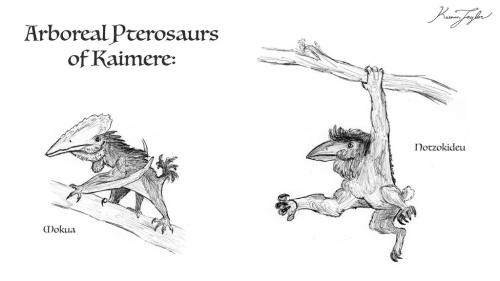#kaimere
In Kaimere’s history, two lineages of pterosaur have independently evolved derived arboreal adaptations.
On the left is the more basal mokua, one of about a dozen species of tapejarid pterosaurs throughout Kaimere with tree-climbing adaptations, such as smaller wings, more compact head and neck, and an opposable thumb. Some of these animals are frugivores. The mokua is mostly an active predator of small game, their blade-like lower jaw cutting into prey, although they do take advantage of fruit at the height of their season. This clade has widespread success throughout Kaimere, with species found throughout the forests of the known world and beyond.
To the right is the notzokideu, the most derived pterosaur of Kaimere. These omnivores are highly intelligent, talented in mimicry, and extremely swift and dexterous in the trees. They are azhdarchids that evolved after Pakardia broke off from the south polar continent 80 million years ago, exploiting the bountiful fruigivore niche that, at the time, was only exploited by ground-based animals. As Pakardia moved north and fruit bats, monkeys, and frugivorous birds were introduced, suddenly this niche became highly competitive. Now the 90-200 pound notzokideu is the last surviving member of their clade, with small populations that spread onto the mainland, but most remain in Pakardia, holding on where their smaller cousins could not.
I speak in brief about these two groups in my latest video, What Is Speculative Evolution, using these animals as examples of convergent evolution. https://www.youtube.com/watch?v=b-NwQux9_w4
Post link

